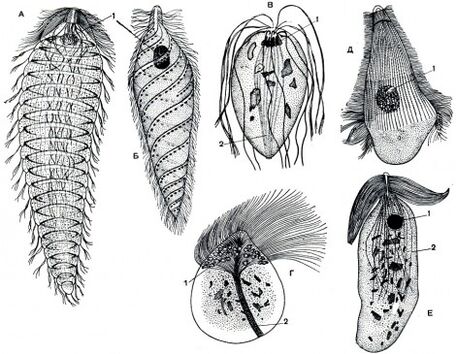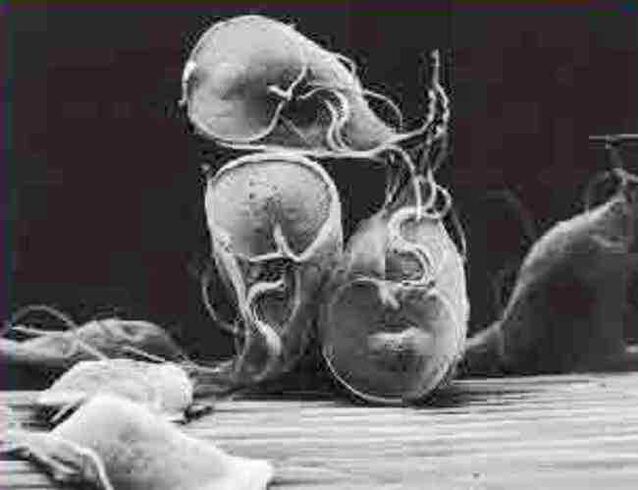Today, diseases caused by many protozoa and helminths are widespread. The danger of such diseases is explained not only by the complications and disorders in the body caused by protozoa and worms in humans, but also by the complexity of the diagnosis of the disease due to the similarity of symptoms with various non-parasitic diseases.
Caused by helminths and protozoa:
- disorders of the gastrointestinal tract (constipation, diarrhea, vomiting);
- allergic skin reactions;
- general intoxication of the body;
- muscle and joint pain;
- dehydration.
It is important to accurately determine the type of helminth and the degree of infection in order to avoid a diagnostic error and to prescribe an inadequate course of treatment that will simply be ineffective at best and can lead to complications at worst. body with them.
Ways of infection with protozoa helminths

All worms enter the body from the outside. It is the same with the simplest helminths. In the environment, they live on land and in water bodies. Unwashed hands, low-quality products can be infected at home, in contact with the carrier, as well as food.
The main mechanism of any infection is oral-fecal, ie a person simply swallows worm eggs with food and water, and some helminthic infections occur when bitten by infected insects less often.
The simplest worms that live in humans belong to the class of single-celled organisms. The infection is called protozoa. Depending on the type and degree of invasion, the course of the disease can be severe and even fatal.
Which helminths are called protozoa?
The simplest helminths can have a stable shape (ciliates and flagellates) and a changeable body - a bright representative of the amoeba. Their size is very small and ranges from 4-5 micrometers to 1-3 millimeters. The cells of these microorganisms often have several nuclei. Pseudopodia, eyelashes and flags act as organs of movement. The process of reproduction occurs in half, depending on the species, or in a complex sexual way.
To protect themselves from adverse external conditions, as well as to spread further, the simplest helminths can turn into cysts, which are cells covered with a protective membrane. This allows them to move from an inactive cyst to an active state if they enter a favorable environment.
It is often the case that the carrier's body does not feel even the simplest helminths that contain parasites. In other cases, the occupation causes the death of the landlord. For example, some antelope species in Africa are permanent "masters" of trypanosomatids. And a human bite from a Chechen fly carrying these helminths can infect them and cause a sleep disorder known to be life-threatening.
The most studied protozoan helminths
Parasites belonging to the flagellate class in the human body:

- Giardia is a parasite that usually lives in the intestines, bile ducts and liver of vertebrates (humans and animals). They can be transmitted through food, water and other factors. This group of protozoa is the cause of a disease such as giardiasis - a functional disorder of the gastrointestinal tract, ie the small intestine. Many patients with Giardia do not experience any obvious symptoms.
- Leishmania are the simplest helminths carried by mosquitoes. After being bitten by insects, a person is more likely to develop leishmaniasis. Symptoms of the disease are damage to the skin, mucous membranes and some internal organs, often fever and anemia become symptoms of the disease.
- Trypanosomatids are protozoa transmitted by insects. When they become infected, they cause trypanosomiasis. There is a long course of this disease. Depending on the type of trypanosomatides, different systems and organs are affected.
- Amoeba dysentery parasitizes the intestines. The invasion takes the form of a 4-nucleated cyst. Although dysenteric amoebae are found almost everywhere, the highest incidence is in tropical countries. Amoebae are the cause of infectious protozoal diseases such as amoebiasis in humans. The clinical picture of the disease is ulcerative colitis, characterized by relapses and exacerbations. There are also cases of non-intestinal form of amebiasis - these protozoan helminths pass from the intestines to other organs and even to the skin. The last form of the disease is called skin amebiasis - there are ulcerative-necrotic symptoms found in the hips and perineum.
- Trichomonas causes trichomoniasis. Several subspecies of Trichomonas have been studied. Intestines and helminths with a parasitic area in the large intestine do not cause much damage to the intestines. As the name suggests, genitourinary Trichomonas is an area of parasitism - the genitourinary system. The infection is sexually transmitted. This subtype of protozoa is the cause of a disease such as trichomoniasis. This infectious disease manifests itself with inflammation of the genitourinary system. Oral trichomonas parasitizes the oral cavity and does not pose a threat to humans.
Sporophytic species of protozoa are represented by malaria plasmodium and coccidia:
- Plasmodium falciparum is the simplest microorganism transmitted by mosquitoes and causes malaria. Parasitizes the blood. Malaria infected with this parasite manifests itself with the following symptoms: hypochromic anemia, febrile seizures, enlargement of organs such as the liver and spleen.
- Coccidia are protozoa that live in the intestinal epithelial tissue of many animals. The causative agent of a disease such as coccidiosis is a number of types of coccidia. In humans, the disease occurs with mild intoxication and gastroenteritis or enteritis.
Eyelashes: balantidia. This rupture of protozoa living in the large intestine is the cause of a disease such as infusor dysentery (balantidosis).
Diagnosis and treatment of protozoa helminths
Very often, when the presence of helminths in the body occurs without symptoms, the disease is not diagnosed for a long time. Invasion can be suspected with specific symptoms and can be detected only by laboratory tests of feces, urine, blood and fluids obtained by puncture from various organs and systems.
In medical practice, there are general principles for the treatment of protozoal invasion:
- antiparasitic drugs;
- non-steroidal anti-inflammatory drugs;
- drugs for detoxification;
- narrow-target antibiotics with the manifestation of secondary bacterial infection.
Specific treatment is prescribed by a doctor based on the type of protozoa helminth and the degree of invasion.




































